Chilean wines - Grape Expectations
Centurion Magazine
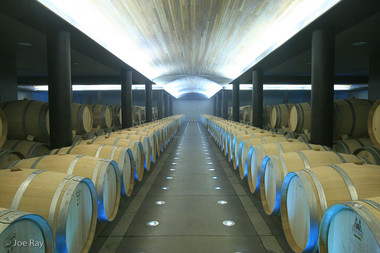
Help from foreign sages can be seen as a sign of weakness. In Chile, however, the wine industry is being pushed forward with the help of outside winemakers. This is helping the reputation of wine in Chile to progress from good, solid stuff to wines that really solicit genuine emotion from the drinker.
“They‘re looking to find a soul,“ says Frenchman Jacques Begarie, chief viticulturist and winemaker for Chile’s Casa Lapostolle and its top-end Clos Apalta label, giving them a bit of what he calls the “French Touchâ€. Looking like the French version of Hollywood western actor James Coburn, Begarie enjoys the challenge of Chile, where wine country still has a frontier edge to it.
Though Chileans have enjoyed making and drinking wines for centuries, their wines have reached the world stage relatively recently. Right now might be the most interesting part of the story: winemakers are able to consistently create something good and some of the best here are beginning to stake their claim.
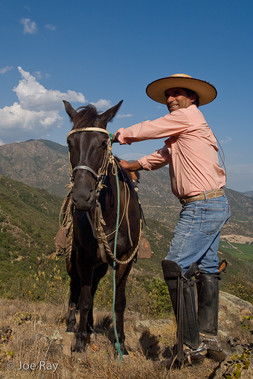 A Chilean cowboy - known as a Huaso - in the hills above Casa Lapostolle.Photo by Joe Ray
A Chilean cowboy - known as a Huaso - in the hills above Casa Lapostolle.Photo by Joe Ray
“Michel Rolland called me in 2004 and said he needed some help. I came for six months and have been here ever since,†says Begarie, referring to Casa Lapostolle’s star consultant – a controversial ‘flying winemaker’, who jets around the world and (depending on whose side you are on) helps or homogenizes wine offerings.
Begarie, the former technical director for Bordeaux powerhouse Vins Dourthe, came with his own take on things, such as stressing the vines to create better grapes. This is perfect for a lot of Casa Lapostolle’s land, which is a thick layer of granite topped with a sandy layer. Growing fewer grapes in tough conditions is hard on vines and production amounts, but makes for excellent grapes. “It’s much better if you produce less than more,†he says. This flies in the face of what has happened historically on most Chilean vineyards, where wine is produced and sold in bulk, but it is also bolstering the country’s reputation.
“We’re not used to drinking good wine,†says Diego Urra, Casa Lapostolle’s brand ambassador. “Chileans drink 16 litres of wine a year, and 15 of those are in Tetra Paks.â€
“If Casa Lapostolle came to me and said, ‘We want lots of wine from this plot,’†counters Begarie, while lighting a Lucky, “I’d say, ‘Nice to meet you,’ and hit the road.â€
There is reason for him to stay. Wineries in the Colchagua Valley are protected to the east by the Andes and by the Cordillera de Costa (the Coastal Mountain Range) to the
west. The region’s hot and bright days, cold nights and predictable rainfall make for ideal grape-growing weather.
Urra guides me through the Lapostolle winemaking process, showing that though the grapes are stressed in the fields, they are coddled the rest of the way to the bottle. Bunches are hand picked and hand de-stemmed, and in the winery, a gravity-only system completely eschews the pumps that can manhandle flavours out of the grapes.
The grandson of a French winemaker, Urra brings me into the cellar to preview the 2007 wines, drawing out a glass tube of Merlot from the barrel. Though tannins keep the strong berry flavours locked up, it already smells ready to roll. Next, we try a Carménère straight from the cask. “There’s a lot of coffee in it,†Urra offers. “My foot!†I think, smelling only what I want to smell. Until the second whiff. Call it the power of suggestion, but it is stronger when I take a sip. Keep an eye open in 2010 when the wines made with these grapes start hitting the shelves.
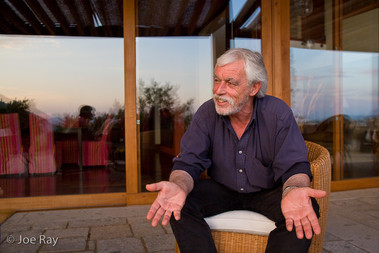 “If Casa Lapostolle came to me and said, ‘We want lots of wine from this plot,’†counters Jacques Begarie, while lighting a Lucky, “I’d say, ‘Nice to meet you,’ and hit the road.†Photo by Joe Ray
“If Casa Lapostolle came to me and said, ‘We want lots of wine from this plot,’†counters Jacques Begarie, while lighting a Lucky, “I’d say, ‘Nice to meet you,’ and hit the road.†Photo by Joe Ray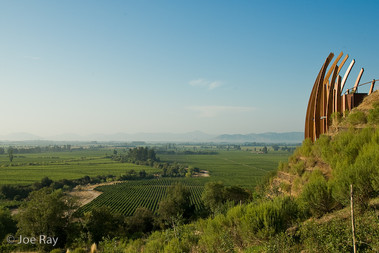 The winemaking facility and vineyards at Casa Lapostolle.Photo by Joe Ray
The winemaking facility and vineyards at Casa Lapostolle.Photo by Joe Ray
Leaving the Colchagua, I head south into the Maule Valley and the Reserva de Caliboro winery, where producer Francesco Cinzano is determined to follow a similar path. “This was the first wine producing section of the country,†he says. “At harvest time, all you see on Ruta 5 [Chile‘s main north- south axis] are trucks full of grapes.â€
Once we get off the highway, cross the Loncomilla River and head east toward Villa Alegre and the Reserva de Caliboro winery, the soil and air go dry and the hills turn gold. Half joking, Cinzano says: “We call this place the Serengeti.â€
A member of the family famous for bringing vermouth to Italians and the rest of the world, the president of the Brunello de Montalcino consortium – and a real-life count – Cinzano found his perfect setting to make a boutique wine, a place where he could stress the vines, dry farm (watering only “when my son’s inheritance is in perilâ€) and create grape bunches that would make Japanese greenhouse-melon producers jealous.
“When I did my search in 1992, the Internet didn’t work so fast, so I’d look at military maps and talk to geologists,†he says of his quest for the perfect place to grow grapes. “The Chileans are very hospitable and they’d send me from one house to the next.â€
A stout belly, slicked back hair, a penchant for Cuban cigars and a larger-than-life presence give him more than a passing resemblance to Hemingway.
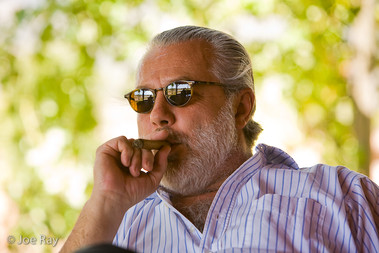 “I’m very good at growing grapes with good, thick skins and lots of goodies in them,†says Cinzano. “Then I deliver them to the cellar and they‘d better not screw it up.†Photo by Joe Ray
“I’m very good at growing grapes with good, thick skins and lots of goodies in them,†says Cinzano. “Then I deliver them to the cellar and they‘d better not screw it up.†Photo by Joe Ray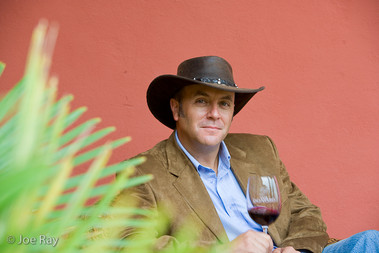 “For my first job, I was 25 – I was a specialist in Coca-Cola,†jokes Alvaro Arrigada. “Nobody here drinks wine when they‘re 25.â€Photo by Joe Ray
“For my first job, I was 25 – I was a specialist in Coca-Cola,†jokes Alvaro Arrigada. “Nobody here drinks wine when they‘re 25.â€Photo by Joe Ray
“My father pulled it off better, but without the gin,†says Cinzano, shrugging off the comparison. That said, you get the feeling that if you were in the mood to go on a big, expensive bender, he would be the perfect companion.
“I’m very good at growing grapes with good, thick skins and lots of goodies in them,†says Cinzano. “Then I deliver them to the cellar and they‘d better not screw it up.â€
Chilean Alvaro Arrigada, chief oenologist and general manager at Casa Donoso, creates a striking contrast. Dressed in his trademark Australian cowboy hat (complete with what look to be shark‘s teeth and alligator skin), he is the symbolic precursor to the next generation of Chilean winemakers – one who has understood the outside world‘s lessons and is now applying them to his winery. “You open your mind and you understand that you need more influence,†he says.
Arrigada’s foreign influence started far from wine country. He spent a high-school exchange year in Yellville, Arkansas, “Home of the Razorbacks!†[the university sports team] he says, with a bit of pride for the Natural State, the nickname for Arkansas. “It was my first time out of the country. I was in the track-and-field team – when you play a sport and aren’t that bad, people love you.â€
He is modest about his beginnings as a winemaker. “For my first job, I was 25 – I was a specialist in Coca-Cola,†he jokes. “Nobody here drinks wine when they‘re 25.†A vertical tasting (tasting wines from one winery, but different vintages) of his boutique blend, D, gives a clear view of what he has done in his time at Casa Donoso. In a sense, we are drinking Arrigada‘s work and seeing him come into his own. The 1997, which was designed to be drunk around 2000, still holds up. It has a nicely concentrated fruity smell, particularly pear, in its cabernet sauvignon and carménère combination. We taste 2003 and 2005 versions of D, the latter with the addition of cabernet franc and malbec, which lend depth and complexity.
Back at Reserva de Caliboro, I ask Cinzano for five minutes by myself with his wine – a request that feels like I am asking for time alone with his daughter.
He sends me out the back with a bottle of 2003 Erasmo and a big glass. I sip the cabernet sauvignon, cabernet franc and merlot mix, noting its deep and rosy red colour, medicinal cherry and liquorice smells and subtle oakiness. It is both a personal wine and a larger symbol of the growing quality of Chilean wines – a scribble on the side of my tasting notes reads: “Where is my lover to drink this with?â€
“This project is to show what Chile is capable of,†says Cinzano. “I know what it means to make millions of cases at low margins and I’ll never do that again.â€
“It’s like you’re after the Holy Grail,“ concludes Casa Lapostolle winemaker, Begarie. “You know you’ll probably never get there, but it’s a good path. If you can put pleasure into a bottle, you’ve done great.â€
See the .pdf version of this story as it ran in American Express Centurion Magazine here